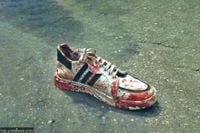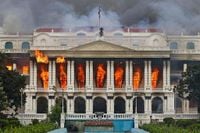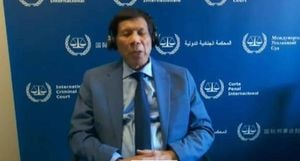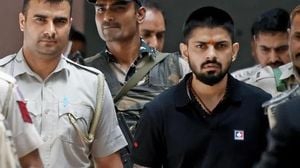Images of a blood-soaked white shoe have ricocheted across Nepal’s social media feeds for weeks, crystallizing a nation’s moment of upheaval into a single, unforgettable symbol. But whose shoe was it, and how did it come to embody the hopes and anguish of Nepal’s Gen Z rebellion? The answer lies with 28-year-old Prakash Bohara, whose personal journey mirrors the struggle of his generation—one marked by frustration, resilience, and a longing for change.
On the morning of September 8, 2025, Kathmandu’s streets were alive with the energy of protest. Young Nepalis, many in their twenties, surged toward the Parliament building in New Baneshwar, demanding an end to corruption and the promise of jobs at home. Prakash, a health assistant from Dailekh, was among them. He had traveled far, not just in distance but in experience—having once served in the Russian army during the war in Ukraine, a desperate move to support his family when opportunities at home dried up. According to OnlineKhabar, Prakash’s story took a dramatic turn that day. As he pulled at the iron bars of the Parliament gate, a bullet struck his left leg, tearing through veins and nerves, and sending him tumbling to the ground.
“I was pulling at the iron bars [of the building] when a bullet struck my left leg,” Prakash recalled softly from his hospital bed at Kathmandu’s National Trauma Centre, as reported by OnlineKhabar. The chaos that followed was captured on video by his brother-in-law: the white shoe, the rush of blood, frantic shouts, and the desperate race to the hospital. In the confusion, Prakash’s left shoe—soaked in red—was left behind, soon to become the viral emblem of Nepal’s Gen Z uprising.
But the story of that shoe stretches back months and across continents. After returning from Ukraine, Prakash used his soldier’s pay to buy a motorbike and, on May 8, 2025, a pair of discounted Samba-brand white trainers in Nepalgunj for Rs1,500. He sent a photo to his wife, Radika, via WhatsApp. She loved them and urged him to buy them. Those shoes, rarely worn but deeply cherished, would one day become part of history.
For Prakash’s family, the news of his injury was devastating. His wife, Radika, and their 16-month-old son learned of his involvement in the protests only from neighbors who saw his name among the injured. “He had promised to be home for Dashain,” his mother told OnlineKhabar through tears at the hospital. “Instead, we got this news.” Doctors say his recovery will be long, with more surgeries ahead, but Prakash remains hopeful. “If the blood I spilled can bring about good governance and end corruption, then it will not have been wasted,” he said, his words resonating with the aspirations of countless young Nepalis forced to seek dignity and survival abroad.
The shoe’s journey from a dusty shop in Nepalgunj to the viral feeds of a nation is more than just a tale of personal misfortune—it’s a symbol of a generation’s struggle. Nepal’s Gen Z, like Prakash, is fighting for a future where jobs and dignity don’t require risking life in foreign wars. As OnlineKhabar notes, the white shoe is now “the emblem of a struggle shared by countless young Nepalis: a fight for dignity, for jobs, for a country that does not force them to seek survival in foreign wars.”
Yet the impact of Nepal’s Gen Z uprising has not been confined to its borders. The shockwaves reached far-off France, a country where Nepal is better known for Mount Everest than for political turmoil. This time, however, the world took notice. On September 12, 2025, the popular French talk show Quotidien, hosted by Yann Barthès, devoted a segment to Nepal’s youth-led revolution, drawing in 1.26 million viewers. According to OnlineKhabar, this was the first time many French people had seen Nepal in the news for something other than mountains.
The French media, including Libération and Le Figaro, published more articles on Nepal in a single week than in the entire year prior. The absence of Western journalists in Kathmandu during the protests was itself a talking point, highlighting how global narratives can overlook the struggles of smaller nations. French social media buzzed with dramatic videos from Kathmandu—some true, some misleading. Footage of protesters supposedly armed with rifles and rumors of the Nepalese Finance Minister being chased into a river (a video that racked up 1.8 million views) fueled the imagination of French viewers. “That’s what we’ll have to do tomorrow,” commented one user, referring to upcoming demonstrations in France. These posts, amplified by the freewheeling environment of X (formerly Twitter), stoked both solidarity and misinformation.
The resonance was not just virtual. On September 18, 2025, over 500,000 people marched across France to protest political instability, with union CGT claiming over a million participants. Some demonstrators openly cited Nepal’s Gen Z movement as inspiration. Anasse, a SUD-Rail unionist, told a crowd, “Did you see the images of the Nepalese Parliament in flames? The stars are aligning.” His words, captured and shared by a Le Figaro journalist, echoed through the French protest movement. Lucca, a French-Brazilian student, told the World Socialist Web site, “Everyone must come out and demonstrate, because today, everyone is affected. Everyone must mobilise, we must do as they did in Nepal.”
Still, the differences between the two uprisings are stark. The French protests, though large and energized, remained mostly peaceful, with 309 arrests and 134 detentions, and far fewer injuries than in Nepal, where 74 people died and hundreds were hurt in a single week. French protesters even briefly entered the Ministry of Economy and Finance but left peacefully after ten minutes—no fires, no violence, just a pointed demand for change. As Interior Minister Bruno Retailleau put it, “In most cases, the protests were conducted under proper conditions.”
The core issues also diverge. While Nepalis rose up against corruption, nepotism, and the lack of opportunities at home, the French protests focused on working conditions and political gridlock. And the outcomes? Nepal experienced a temporary governmental shake-up and a flicker of hope, while France remains mired in political uncertainty, with little sign of lasting change.
Yet, the symbolic connection endures. From the streets of Kathmandu to the boulevards of Paris, the image of a bloodied white shoe speaks to the universal yearning for dignity, justice, and a future worth fighting for. For Prakash Bohara and his generation, the cost has been high—but their struggle has inspired not only their own country, but young people a continent away.
As the dust settles on Nepal’s Gen Z uprising, the echoes continue to ripple outward, reminding the world that sometimes, even a single shoe can carry the weight of a generation’s dreams.





